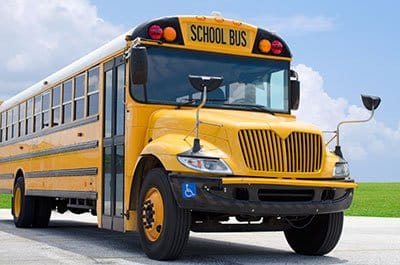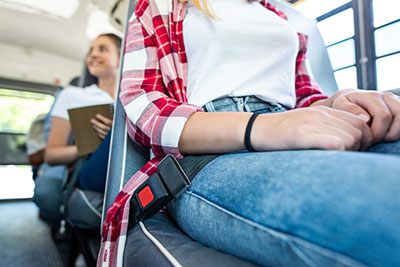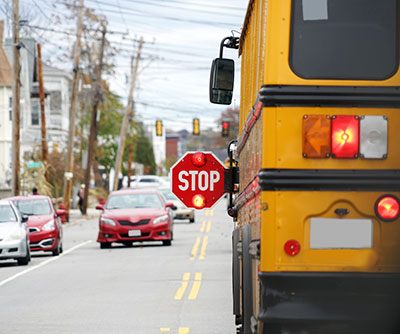School buses are the primary means of transport for schoolers. That's why they are much safer than the regular buses.
You must be wondering: What are the school bus safety standards & how to ensure the child's safety on the road?
We talk about the official school bus safety regulations, tips on how to keep your children secure in the school buses, and school bus laws.
More...
Take away key points:
Table of Contents
School Bus Safety for Children: What You Need to Know
Each year, school buses transport more than 25 million kids to and from schools, as the American School Bus Council - ASBC claims. The NHTSA believes school buses must be the safest vehicles for children. Therefore, school buses must meet multiple standards and regulations for the safest use. Let's get straight into the topic.
What is a school bus?

A school bus is a motor vehicle with a capacity of eleven and more people - including the driver. For the NHTSA's safety school bus rules, the school bus is a motor vehicle with a specific purpose - transporting students to and from school.
A school district or a State might also define the vehicle, differing from the NHTSA's definition. However, the differences do not exclude or affect the NHTSA safety standards.
All officials must follow the primary rule: a new bus leased or sold for student transportation must exceed all Federal school bus standards (FMVSS) set by the NHTSA. You can find more about the National Motor and Vehicle Safety Act here.
School bus safety facts
Children between four and six years old die yearly on school transportation, less than one percent of all traffic fatalities nationwide, as the NHTSA states. In addition, school-aged kids are around 70% able to get to school safely when taking a school bus instead of other passenger vehicles.
A school bus is the most regulated vehicle on the road. It's designed to prevent crash injuries so that school children will be safer than in other cars. In each state, the stop-arm laws protect kids from other motorists, increasing their security in school transportation.
How do school buses stand out?
School bus safety is increased and different than in other vehicles due to the following reasons:
School bus safety & seat belts

Seat belts have been obligatory in motor vehicles since 1968. Multiple states and the District of Columbia have laws requesting light trucks and passenger seat belt systems.
Seat belts play a crucial role in collisions, keeping all passengers safe and protected from severe injuries. However, school buses are specific in design, using different child restraint systems that work well in transportation.
Large school buses are heavier due to the construction. They distribute crash impacts and forces differently than light trucks and passenger cars. Due to these differences, claims the NHTSA, school bus passengers experience fewer crash forces than those in light trucks, passenger cars, or vans.
The best way to prevent school bus crashes and keep children safe is through the so-called "compartmentalization." Compartmentalization means children do not need to buckle up inside the school bus. Instead, the interior of the large school bus and the school bus seats will protect the kids.
The interior of the school bus offers solid and closely-spaced seats with energy-absorbing seat backs. Thus, the inner construction protects children from crashes.
Small school buses (up to 10,000 pounds of maximum weight) must provide lap or/and shoulder/lap belts at all seating positions. As the small school bus' weight matches those of passenger cars, light trucks, and vans, seat belt systems in these vehicles are obligatory to provide passengers safety during transportation.
School bus stop & safety standards
The biggest risk of accidents and injuries for your children is not on the bus but when leaving or approaching the vehicle at bus stops. Both parents and children must know the traffic safety rules before kids start or return to school. Parents should teach their children the following safety tips to make school bus transportation more secure.
Safety tips for parents
Below you can find crucial rules at the bus stops:
Safety tips for bus drivers
School bus drivers have the most vital task: keeping students safe. The drivers must follow these steps:

In addition to the rules, the NHTSA also provides the improved School Bus Driver In-Service Curriculum. The curriculum refers to regular training, vital for a driver to stay up-to-date with all new regulations. The driver will maintain and improve the security of students in and around the bus.
School bus law
The NCSL acquired a specific school bus law regarding the camera and seat belt system. The seat belt law is similar to the NHTSA's regulations and law. However, the bus camera law includes the following statements:
School bus & the kids with special needs
The Traffic Injury Prevention Project is sponsored by PennDOT, providing parents, caregivers, hospitals, schools, and similar facilities with the latest information about the atypical transportation for children with specific health needs. The project includes particular child restraints, wheelchairs, buses, and similar transporting devices. Please call 1-800-CAR-BELT for more information.
FAQs
What is the safest part of a school bus?
The safest part of the school bus is in the middle between the tires, in an aisle seat on the right-hand side. It's the safest part in rear-end, head-on, and side crashes.
What are the danger zones of a bus?
The danger zones of a bus are the immediate surroundings of the bus. The zones include ten feet in front, at the back, and ten feet from the side of the bus.
What are the safety measures for riding a bus?

The safety measures in riding a bus include:
What are the most common types of school bus accidents?
The most common types of school bus accidents include:
- Accidents including other vehicles
- Accidents involving pedestrians
- Accidents including bus occupants
Why do school buses not have seat belts?
School buses don't have seat belts because their interior protects children from injuries. The stop-arm laws in every country also prevent children from accidents in buses.
Final Words
Following the school bus safety procedures and tips is the safest way to keep your children secure in buses. You must train your kids to respect the drivers and rules to avoid accidents and fatalities. The restrictions apply on board and off the buses as well. Otherwise, the pupils won't be secure.
